Sports and it’s Disasters
@Compiled by Asim DEb
Throughout the history of sports, numerous hazards endangered the participants and often the spectators, from severe injury to tragic death, sometimes stadium disasters, acts of violence and doping. Sometimes the victims survive, but often not. But still the demands from professional players are intolerable. Today’s greed of sports, the business and self interest for playing more tournaments at greater pressure across the globe has all but wiped the kind of grace from sport’s scene.
Collision at high speed is inevitable and soccer is a sport in which the tearing of flesh and breaking of bones are accepted hazards. At the highest level of competitions, the players are billionaires and millionaires, and they accept that sometimes the body cannot keep up with their stamina. And with the potential threats in their career, they continue playing even when they well understand for their own medical attention, but they ignore. To add, now basketball, cricket, car racing, boxing, wrestling, all are equally endangered. But for some people, pain is just a minor inconvenience on their road to glory, which became fatal at the later stage.
In 1973-74, Shyamal Ghosh, the dependable defender for East Bengal Club had number of stiches on his forehead just on the day of Calcutta derby match, against Mohan Bagan. But he played with his forehead stitched. He had to clear a floating ball in his penalty box area, he jumped to clear the ball by heading, and his stiches got torn but he continued playing with the blood soaked bandage. Another example was Subhas Bhowmick the heavyweight bulky footballer in Calcutta soccer. Playing against Mohan Bagan, he could not keep his body balanced during a ball chase and not intentionally but accidentally jumped upon the thigh of Mohan Bagan defender Sankar Banerjee. Sankar had to leave the field immediately and for ever.
In 1962, India’s young captain Nari Contractor was left critically ill after being struck on the head by West Indies fast bowler Charlie Griffith. He made a remarkable recovery but could never return to the game,
During 1970 FIFA World Cup against Italy, the German Franz Beckenbauer, then only 24 years old, had suffered a dislocated shoulder after a foul by Italy’s Pierluigi Cera in the 70th minute. Beckenbauer struggled with his right arm, with a broken collar bone dislocated at his shoulder, simply wrapped up in a sling fixed to his body by tape and his hand on the German FA badge just below his heart, through the full 90 minutes of the game and then 30 minutes of extra time. He played on, elegant as ever through The Azzurri ended up going through to the final, thanks to Gianni Rivera’s goal in the 111th minute that clinched a 4-3 win, but Germany, and Beckenbauer in particular, had won many plaudits. The man put in a fantastic performance in one of football’s greatest matches. London’s Evening Standard praised him as a “wounded, beaten but proud Prussian officer.” Veteran striker Uwe Seeler, of Hamburg, was the West Germany skipper during the tournament, but the elegant, effortless Beckenbauer had become the team’s fulcrum at his second World Cup.
In 2002 Zinédine Zidane, three weeks after winning Champions League final that May, he injured his thigh muscle playing warm-up for France against South Korea in Seoul. So, he missed the 2002 FIFA World Cup first two matches. He returned in desperation for the third, but it was a hapless Zidane, trying to play with only one leg. The 1998 world champion was eliminated in round one. Then FIFA promised a revision of the international calendar to protect star players from being overplayed.
One by one, they fall. Michael Ballack, the captain of Germany. Rio Ferdinand, captain of England. Didier Drogba, the leader of Ivory Coast. Michael Essien, Arjen Robben, Wilson Palacios, John Obi Mikel, each of them influential on their national teams, were either out or doubtful for the World Cup for similar reasons.
Ferdinand had a ligament injury during training in South Africa when he challenged Emile Heskey for the ball; Ferdinand’s left knee was wrenched when his shoe caught in the turf. It is hard to weigh a player’s mind when he is told he is out of a tournament that would define his career. Ferdinand could play again, but not in the next five or six weeks. He was moved on crutches, for transportation and thus out of his World Cup, and reduced him to playing only 13 games for Manchester United that season.
Drogba, ranked as Africa’s one of the most accomplished soccer players, was clinging to hopes of a miracle cure for his broken right arm. He had the bone fractured just below his elbow. When the Ivory Coast camp blamed Japan’s Brazilian-born Tulio for the aerial tackle with Drogba, it seemed wise to wait for hospital diagnosis. “For him, the World Cup is finished,”
German player Bastian schweinsteiger played in the FIFA world cup final 2014 even though he had a scar in his face. Yet, what is less known is that the German never revealed that he was playing through the season with a serious ankle injury and later revealed that he would need surgery for his damaged ankle.
Butcher, playing for England in a vital qualifier for the 1990 World Cup against Sweden, he suffered a head injury. A collision early in the game created a gash on his head, which England’s trainers haphazardly bandaged but Butcher kept on heading the ball, thus opening up his wounds deeper and deeper. His effort in central defense earned England a 0-0 draw and a birth in 1990 FIFA World Cup, but it left him bloodied and maniacal looking. The English centre back received stitches in his forehead, on the side of the pitch, before returning to play.
March 2010., in the Champions League Quarterfinals, Barcelona vs. Arsenal, Fabregas already had bad knee bruise from Arsenal’s previous match against Birmingham. Fabregas was brought down in the box by Carles Puyol, resulting in a penalty. Fabregas took the penalty and converted, but almost immediately went down in pain with a broken right leg.
And if you thought, cricket was not that risky, you might remember that Abdul Razzaq, the Pakistani cricketer, had a narrow escape during a match when he was hit in the head by a ball. This incident again raised concerns about helmet safety and the need for better protective gear. Pakistani bowler Wasim Akram had a scare during a match when he suffered a heart attack. Prompt medical attention saved his life, but it served as a reminder of the health risks associated with professional cricket.
Thus, the greed of playing more often ignoring or hiding a player’s own health at greater pressure has all but often a tragic end of career, sometimes the life.
Threat Even for Life
In 2014, Australian Phillip Hughes was hit in the neck by a bouncer, during a Sheffield Shield match at the Sydney Cricket Ground, causing a vertebral artery dissection that led to a subarachnoid haemorrhage. He died after 2 days, never could regain consciousness, three days before his 26th birthday. In another incident Raman Lamba, a former Indian Test player died while on field, playing in Bangladesh
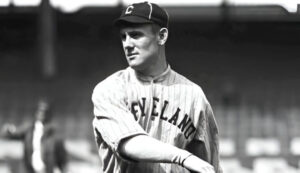
In 1920 Chapman died a few hours after he was hit in the head by a ball thrown by Yankees pitcher Carl Mays. He became the first and only MLB player to-date to die from an injury that occurred during a major league game and his death raised the demand, specially from the ‘50s that baseball players need to wear helmets when at bat.
In 1992-93, defender Sanjiv Dutta, playing for Railways in the Indian National Football Championships, died when a rival player’s elbow sank into his chest during an aerial battle for the ball.
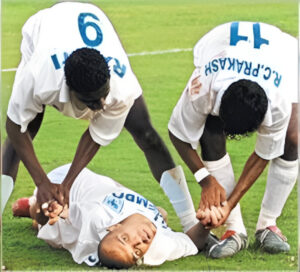
In 2004 Indian Fed Cup final the 24 years old Brazilian Cristiano Junior de lima, who was the highest-paid Indian football players of his era died in the field. In the 78th minute of the finals he had collision with Mohun Began custodian Subrata Pal, while scoring his second goal. Christiano lost control and collapsed on the field just after the dreadful collision. He was rushed to the hospital in an unconscious state and was declared dead on arrival. The autopsy reports later revealed that Cristiano Junior suffered a major heart attack on the field, due to which he lost his life.
Going back to the old times, year 1878. On 27 February 1878 in a friendly against Coalville, the soccer player Herbert Dockerty, just played a long pass, when William Bradshaw, of Coalville, jumped on Dockerty with his right knee, and struck Dockerty in the abdomen. The referee did not award a foul. Herbert Dockerty aged only 20 died of an intestinal rupture the following day. A jury in a trial for “manslaughter” on 21 March 1878, acquitted Bradshaw. In another old times example, on 25 October 1879 English player Harry Rogers, aged 25, captain of the Reading side called for medical help, stating that that he felt “bilious”. He lay down in the field, convulsed, and died.
Now coming to recent incidents, on 10th April 2025, Helar Gonzales Altamirano died in hospital at the age of just 21 after a horror collision during a Copa Peru match when he smashed into a rival team’s keeper as they challenged for a long ball. Being wounded he was stretched away from the field to a waiting ambulance but died in the hospital.
In another recent incident on 6 February 2025, Guo Jiaxuan of China while playing preparation match for Beijing Football Association U20 squad in Spain for the 2025 National Games of China, he sustained a severe head injury with a Spanish club, his head collided with opposition player’s knee. Immediately a helicopter landed on the ground and carried him to the hospital and after four hours, he was declared brain dead. From Madrid, he was shifted back to Beijing for medical care. On 19 March 2025, Guo passed away at Beijing’s Tiantan Hospital, one day before what would have been his nineteenth birthday. Guo Jiaxuan at the age of 18 was a real promising Chinese talent selected for the 2023 season’s Bayern Munich Squad.
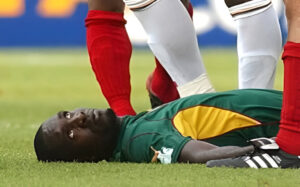
Cameroonian defensive midfielder, Marc-Vivien Foe was capped by his nation for sixty-two times. On 26th June 2003, before the scheduled FIFA Confederations Cup semi-final match against Colombia, Marc Foé’s wife Marie-Louise stated that Marc had been ill with gastric and dysentery, but he was adamant to play in his adopted hometown of Lyon. Cameroon manager Winfried Schafer also wanted to substitute him observing that the player seemed fatigued, but Marc signalled that he wanted to continue. In the 72nd minute of the match Mark Foé collapsed in the centre circle when no other players were near him. He was stretchered off the field, where he received mouth-to-mouth resuscitation and oxygen. Medics spent 45 minutes attempting to restart his heart and although he was still alive upon arrival at the stadium’s medical centre, he died shortly afterwards. A first autopsy did not determine cause of death, but a second autopsy concluded that Foé’s death was related to heart as it discovered evidence of hypertrophic cardiomyopathy, a hereditary condition known to increase the risk of sudden death during physical exercise.
Aggressive Celebrations
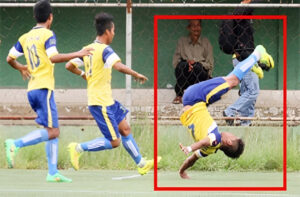
Celebrations after scoring a goal have been a legacy in the game of football; however, in October 2014, the glorious celebration of Peter Biaksangzuala from Mizoram, India at the aged of only 21, turned out to be the nightmare as he suffered a major spine injury after landing awkwardly on the ground while celebrating his goal with series of somersault, and caused severe spinal cord damage. He was immediately rushed to the hospital but lost his life on October 19, 2014.
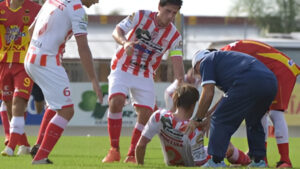
Argentine Cristian Gomez was anticipated by his fans to be the “next big thing” in the world of football. But while playing a friendly football match for Atletico Parana, he collapsed on the field and died after a major heart attack. Although Cristian Gomez was given rapid medical attention, he passed away in the ambulance and couldn’t even make it to the hospital.
The iconic Scottish professional footballer Philip O’Donnell was PFA Scotland Young Player of the Year for 2 seasons. His fate changed after a major cardiac arrest on December 29, 2007, while playing a crucial match for Motherwell against Dundee United. Philip O’Donnell was rushed to Wishaw General Hospital right then however the iconic football player couldn’t battle the excruciating pain and breathed his last a few minutes later.
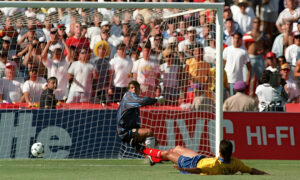
Colombian player Escobar accidentally scored an own goal during their FIFA World Cup group-stage match against USA. Colombia lost 2-1, which eliminated them from the tournament. On July 2, 1994, just days after returning to Medellín, Colombia, Escobar was shot six times outside a bar, after the assassin argued with him about his mistake in that game.
Big Bash League
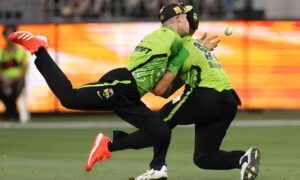
Sydney Thunder pair Cameron Bancroft and Daniel Sams were taken to hospital following a sickening clash of heads during their team’s pulsating four-wicket, final-ball victory over the Perth Scorchers. Bancroft’s BBL season was over with his broken shoulder and broken nose.
Formula One
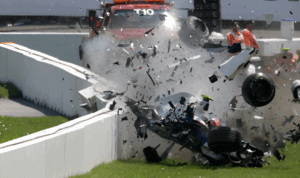
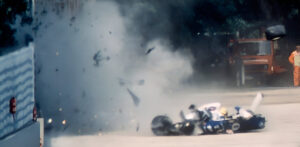
Formula 1 racer Ayrton Senna crashes into a wall during the 1994 San Marino Grand Prix in Imola, Italy. Senna later died at the Maggiore Hospital in Bologna.
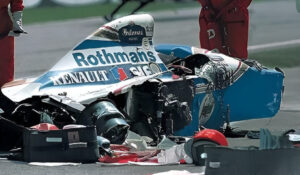
Brazilian Ayrton Senna was killed in an accident while leading the 1994 San Marino Grand Prix. This is undoubtedly one of the most shocking deaths in the history of any sport and Senna remains to-date the greatest and most recent driver to have been killed in a Formula One World Championship event.
The year 1994 is considered to be the black in the history of Formula One racing. The San Marino Grand Prix at Imola, Italy, was a race marred by tragedies. Thirty one-year-old Austrian novice driver Roland Ratzenberger was killed in a high-speed crash during a qualifying session.
Track and Road Cycling Racing
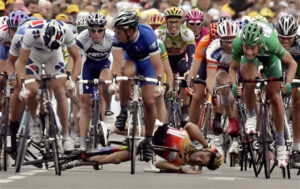
Isaac Gálvez López was a Spanish professional track and road racing cyclist who won the World Madison title twice in 1999 and 2006, both times partnering with Joan Llaneras. Sadly, he died in 2006 at the age of 31 due to injuries sustained in a crash during the Six Days of Ghent track race, appeared to have hit a railing with his chin and chest after crashing into a fellow Belgian rider.
Agostinho, the Portuguese bicycle racers and a six-time national champion. became the victim of one of the most ironic tragedies in the sport’s history. At Quarteira, during the 1984 Tour of the Algarve (he was leading at the time), a dog ran into the race a few hundred meters before the finish line and Agostinho hit it. He fell to the ground and injured his head, a trauma that put him in a coma a few hours later from which he never emerged.
Professional Basketball

Few years after Len Bias’s unfortunate end, Reggie Lewis, another Boston Celtics star, died in his prime when he had cardiac arrest on the basketball court during an off-season practice session in the summer of 1993. Lewis had symptoms of heart problem a few months before, but after a few monthly treatments he was wrongfully cleared to train and play again.
Professional Wrestling
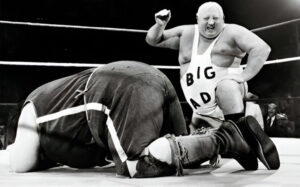
Malcolm “King Kong” Kirk and his partner, King Kendo, were in a tag-team match with Shirley “Big Daddy” Crabtree and Greg Valentine when one of the most tragic events in professional wrestling’s history occurred. The incredibly massive Big Daddy was particularly known for his signature body slams but when he slammed “King Kong” with his famous Belly Splash, Kirk turned gray and looked severely sick. He was immediately rushed to the hospital where he died moments later. According to the doctor who did the autopsy Kirk had a heart condition, so it wasn’t really Big Daddy’s Belly Splash that killed him, but it definitely triggered it.
Death Due to Stampede and Violence
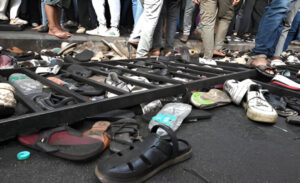
11 fans were crushed to death and more than 50 wounded in a stampede after uncontrolled huge crowd packed the streets in Bengaluru on June 4, to cheer their hero Virat Kohli and other RCB team members.
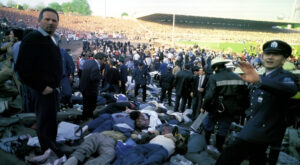
The 1985 European Cup final between Juventus (Italy) and Liverpool (England) was held at Heysel Stadium in Brussels. The Heysel disaster, which occurred on May 29, 1985, led to the deaths of 39 supporters (mainly Italian), 600 injured, and a blanket UEFA ban on English clubs from European competitions for five years (Liverpool for six years). What had started as a peaceful, joyful sporting event ended up looking like a war zone between the two teams’ hard-core fans in what is to this day the most tragic moment in European soccer history.
In 1999, a single stroke of lightning instantly killed a whole soccer team. The eleven players were all between twenty and thirty-five years old. This freak accident happened during a match held in the eastern province of Kasai, in Congo. The strangest thing of all, however, was that the players from the home team came out of this tragedy unscathed.
Peru’s Estadio Nacional Disaster (1964) – 328 Death and 500 Injured.
It was May 24, 1964, at Peru’s Estadio Nacional when Argentina was playing against Peru in a qualifier that would see the winner go to the Tokyo Olympic Games. Argentina was winning 1-0. When Peru scored a goal, the Uruguayan referee, Angel Pazos, didn’t count it (unfairly, according to the reports). This reaction ended up being the deadliest riot in soccer history (between fans and police) and resulted in the deaths of 328 people and saw as many as 500 injured.
Luzhniki Disaster (1982) – 66 / 340 Dead
The UEFA Cup match on 20th October 1982 between Spartak Moscow and HFC Haarlem took place in Moscow, Soviet Union in freezing weather and many fans began leaving early to escape the cold. Only one exit gate at the East Stand was open. When Spartak Moscow scored a late second goal, some fans tried to rush back to their seats, creating a deadly crush in the narrow stairway, which caused a stampede where many were crushed and suffocated. The Soviet government officially reported 66 deaths, but later investigations claimed the real number could have been as high as 340. The Soviets government’s secrecy at the time meant that the full scale of the disaster was kept hidden for years. The Luzhniki Disaster remains a grim example of poor stadium management, lack of crowd control, and the dangers of limited exit points.
Kathmandu Stadium Disaster (1988) – 93 Dead
On March 12, 1988, a sudden hailstorm turned deadly during a football match at Dasarath Stadium in Kathmandu, Nepal when the stadium had around 30,000 spectators. They were panicked and rushed toward the exits to escape, but the gates were locked. As more people pushed forward, those in the front were trapped causing 93 deaths, mostly trampled or suffocated. With exit open exit gates open, a tragedy could have been avoided.
The Munich Air Disaster
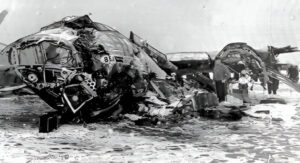
On February 6, 1958, British European Airways Flight 609 crashed on its third attempt to take off from a slush-covered runway at Munich-Riem Airport in West Germany, which caused the death of twenty of the forty-four passengers on-board. The injured, some unconscious, were taken to the nearest hospital where three more died, resulting in twenty-three dead, the vast majority of them players were from the Manchester United club.
Iraq’s Extermination of Athletes, 2006
In the dying days of Saddam Hussein’s regime, a series of attacks on athletes left nearly 50 athletes and coaches either dead or “missing”. On May 17, 15 athletes and officials from a taekwondo team were kidnapped as they were heading to a training camp in Jordan. None were seen alive again, and remains of 13 of the squad were found a year later in the desert. Then on May 26, gunmen shot and killed the Iraqi national tennis coach and two of his players in Baghdad. Their crime was wearing shorts, something that Islamic extremists had warned in the days preceding the attack. And again, on July 16, about 50 gunmen made a daytime raid on a conference centre in Baghdad and kidnapped 30 Iraqi sports officials, including Ahmed al-Hadjiya, the head of Iraq’s Olympic committee.
References:
** sportsdigest.in/footballers-lost-lives
** list25.com/25-tragic-sports-
** www.mirror.co.uk/sport/football/news/
** https://www.youtube.com/watch?v=1XVcmhHoh84
** www.nytimes.com/2010/06/07/sports/
** www.90min.in/posts/4321760-10-instances
** www.espnfc.com/blog/espn-fc-united-blog/68/
** en.wikipedia.org/wiki/Franz_Beckenbauer
** www.complex.com/sports/2013/06/
** www.joe.co.uk/sport/
** Economic Times, Joe.co.uk, NYTimes

********


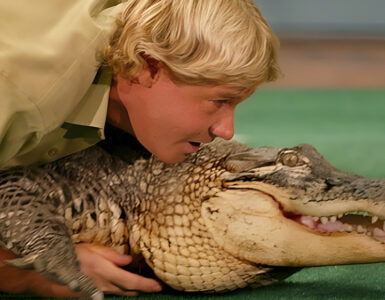
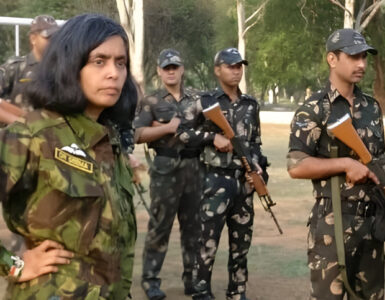











A very new area you have nicely described. This required a wide home work to pile up so many similar incidents of injury from different national and international fields. I am not sure whether earlier any one else has penned down such an interesting and informative article. This requires a wide effort to collect and project on papers.
Thanks for taking the successful effort.
An article on uncommon subject. I have never read so far any article on disaster in sports, be it on the field or off the field. On reading we can make out how much time the author had to spend collecting the information on so many different types of sports.
I wish author would come up with many more such articles in the future.
Thanks author, it’s worth reading.
বিভিন্ন ধরণের খেলাধুলায় চোট আঘাত বা মর্মান্তিক দুর্ঘটনা নিয়ে এরকম লেখা আগে পড়িনি। একেবারেই ভিন্নধর্মী স্পোর্টস বিষয়ক লেখা।
You rightly said, today’s greed of sports, the business interest and playing more and more tournaments at greater pressure even if your health does not permit, but you or your club insist to continue. Many hazards are avoidable but who cares?
On the other side, there is administrative negligence.
Sports is generally a form of art, but often a nightmare, that comes without any notice.
Well written article on important but unusual subject. I have not gone through any such article in the past.
While most of the accidents are in the hands of God, but often players, sometime the clubs, sometime the organisers create many many disasters. Might be individual greed, might be trying to be in the race, but the fate becomes unfortunate.
It’s good that author did a good job to bring it in common.
খেলাধুলায় যেমন জয় পরাজয় আছে, তেমনি মর্মান্তিক পরিণতিও আছে। Sports and Disasters বিষয়ে আর অন্য কোন লেখা আমার জানা নেই, থাকলেও সংখ্যায় খুবই নগণ্য হবে।
কেন হয়, কিভাবে হয় উদাহরন সহ বিশদে বর্ণনা করা হয়েছে।
খেলাধূলার অনিয়ন্ত্রিত পরিনতি নিয়ে এই প্রবন্ধটি খুবই প্রাসঙ্গিক।
Feeling sad after reading so many tragic ends, be someone’s sports career or someone’s life. Sometimes it’s individuals, and sometimes the crowd who gathered to enjoy the fun of sports. The reasons for all the tragic ends are well written.
Good article describing the other side of sports.
Gone through the write up, author has almost covered all the possibilities of a disaster in sports. I would add, giving examples of some of the greatests like Maradona and George Best, that you need to bring yourself under certain non negotiable disciplines. Indian examples are Majid Baskar, Vinod Kambli, may be bowler Srishant, may be few more.
Well written article, highlighting the necessity of utmost care by all concerned.
Accident and its aftermath is an important part of any field, more so of sports arena. It must be a herculean task for the author to gather all the related information. I must say his efforts have made this article an attractive one.
Thought provoking.
I have not read any such article in the past that raises concern for our safety in sports, be it on the field or off the field. Many valid reasons are highlighted how or why these disasters happen. We wish people should be sensible and aware of such possibilities and protect them from such mishaps.
Good article to read.
My sincere thanks for the author, for his hard work and presenting such a composition.. With my full regards for you, I would add two incidents.
First, the Hand of God goal was a disastrous management failure of FIFA..
Second, when Sukolyan Ghosh Dastidar punched on the referee’ nose after the Calcutta durby match sometime around mid 70s.
It’s a wonderful document author, I just wanted to add two incidents.
Thanks
I have taken part in sports only during my school days. It has risk involved, small or big. This article should be a lesson for the sports persons, and even for the administrators.
A good composition of risks and disasters on the field. But there are many examples of sportspersons after earning fame and handful of wealth get addicted to alcohol or drugs or in gambling, on women or so. They not only ruin themselves but also their families.
These are examples of disasters off the field.
এটা একটা অসাধারণ লেখা, এই ধরণের লেখা সাধারণত লেখা হয় না। বিভিন্ন খেলোয়ারদের তাঁদের খেলার ধরণ এবং তাঁদের প্যাশন নিয়ে বলা হয়েছে। এরসাথে এটাও বলা হয়েছে : এখনকার দিনে সব খেলাতেই এতো কম্পেটিশন এবং সাথে এতো এতো টাকা হয় যে প্লেয়াররা তাঁদের শরীর বা স্বাস্থ্যের কথা মনে না রেখেই বেশিরভাগ সময় বিভিন্ন রকমের রিস্ক নিয়েও খেলে যেতে থাকে। তাতে অনেকেরই জীবন বিপদ জনক মোড়ে এসে দাঁড়িয়ে যায় আর তাতে তারা সারা জীবনের জন্য খেলার মাঠ ছাড়তে বাধ্য হয়। আমার ধারণা যেকোনো বিখ্যাত প্লেয়াররা তারা তাঁদের জীবনের বাজী রেখেও অনেক সময় তাঁদের খেলা চালিয়ে যায় সেটা শুধু যে টাকা পয়সার জন্য করে সেটা ঠিক নয়, এটা তারা করে তাঁদের মাত্রা অতিরিক্ত প্যাশন এর কারণে এবং খেলা তাঁদের কে এতটাই উন্মাদনা এনে দেয় যে এরা এদের শারীরিক ক্ষতির পরোয়া না করেই খেলা চালিয়ে যায়। এর ফলস্বরূপ বেশিরভাগ ক্ষেত্রেই তাঁদের শারীরিক ক্ষতির পরিমান একটা সাংঘাতিক ক্ষতির দিকে এগিয়ে নিয়ে যায় এবং তার ফল তাঁদের সারা জীবন ভুগতে হয়। এটাই হয়ে চলেছে যুগ যুগ ধরে। এরা সবাই একেকজন আমাদের কাছে সেলিব্রিটি বা লেজেন্ড হয়ে ওঠে।
লেখককে এইরকম একটা লেখা প্রচুর তথ্য সহকারে আমাদের সামনে উপস্থাপনা করার জন্য আন্তরিক আন্তরিক শুভেচ্ছা রইলো। 👌🏽👏🏽❤🙏🏽
খেলাধুলায় চোট আঘাত হবেই, কিন্তু লেখক যেভাবে নানান তথ্য দিয়ে বিভিন্ন উদাহরণ দিয়েছেন, সে সত্যি ভয়াবহ। খেলোয়াড়রা আরও অর্থ বা খ্যাতির জন্য হোক বা নিজের মানসিক দৃঢ়তার অভাব হোক, এইরকম পরিণতি কখনোই কাম্য নয়। পেশাদার মহলে যদি এই ব্যাপারে কাউন্সেলিং হয় তাহলে অনেক প্রতিভার অকস্মাৎ অকালমৃত্যু আটকানো যাবে।
লেখককে ধন্যবাদ এরকম প্রতিবেদন লেখার জন্য।
Sports and accidents are related, though never desirable but it happens. But it is the saddest part if it turns out to be horrible mishaps. It can be controlled to a great extent if personal councelling can be made a routine in various games.
Author has rightly pointed out various causes with examples.
Wish, good sense prevails in sports community.
Thanks.